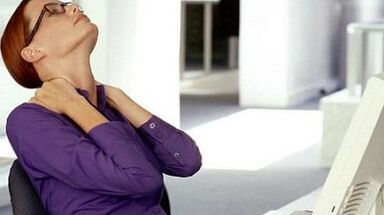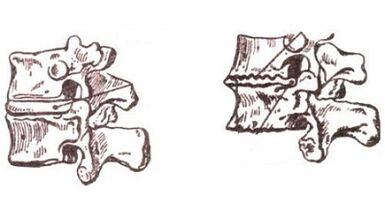
How to cure osteochondrosis of the cervical column and what is the reason for its appearance?This problem worries women and men who are forced to solve health problems problems daily: boring discomfort in the neck with serious headaches and other problems.
The main reason for the development of the disease is to reduce the distance between the vertebrae due to the destruction of the cartilage between them.
For reference.Osteochondrosis in the cervical column is a degenerative-dystrophic progressive disease, is widely used due to excessive mobility of vertebral in the neck.Osteochondrosis of the spine causes uncontrolled physical activity, injuries and a low muscle corset.All these causes finally lead to the development of cervical osteochondosis.
Etiology of the disease
The main reason why cervical osteochondosis is developing is to reduce the distance between the vertebrae due to the progressive destruction of cartilage between them.Any unsuccessful position causes the vertebrae's offset and the vessels and nerves are pinched.
The most characteristic causes of the development of osteochondrosis:
- Genetic predisposition to disease.
- Excess weight and metabolic disorder.
- Frequent infections, body intoxication.
- Poor lower nutrition with the minimum intake of vitamins, original and liquids, which leads to the deformation of the vertebrae.
- The curvature of the spine, injuries, bruises, fractures, violation of the posture (osteochondrosis of the initial department).
- Flat feet and instability in vertebral segments, including in the bodies of cervical vertebrae.
- Work associated with weight lifting or frequent changes in body position (shock, turning).
- A sedentary lifestyle, a bad ecology.
- Perform hard work with an unmanned bone muscle system, which leads to the deformation of the vertebra.
- A long -term forced position of the body, nervous overvoltage and stress.
- "Bad" sleep pillows that modify the position of the vertebrae in the cervical region.

A sedentary lifestyle increases the risk of the disease.
It is important to remember that the beginning of osteochondrosis cannot be noticed.This is why, with unpleasant sensations in the neck, it is necessary to contact a specialist in a timely manner.
The following causes of osteochondrosis are theoretical, but found in practice:
Involutionary
They are associated with an alteration of tissue trophies during the aging of the body, which applies mainly to intervertebral discs and vertebrae, where a large number of blood vessels pass.
Hormonal
With hormonal disorders, dystrophic changes (osteochondrosis) occur in the body, involving intervertebral discs in the process.
Vascular
They are observed in the event of violation of segmental circulation and metabolism of water salt.Subsequently, dystrophic changes are formed in tissues and organs, including osteochondosis of the neck.
Infectious
The infection that occurred in the intervertebral discs of the cervical column and surrounding tissues disturbs the diffusion of the lymphatic fluid and leads to a change in the cervical tissues and vertebrae in nutrition.This is what causes degenerative changes to the spine inherent in osteochondrosis.
Bioelectricity
The inversion of the vector forces of the bioelectric fields of the intervertebral disc occurs due to injuries, overloads and temperature changes.In the end, osteochondrosis of the spine appears and most often polysegent.
Mechanical
Significant injuries and overloads in the spine lead to a violation of the integrity of the fibrous ring and the dystrophy of the discs of the cervical column.
Anomaline
This refers to the congenital anomalies of the spine and its individual structural parts.At the same time, the healthy vertebrae of the cervical region take a double charge, which leads to their rapid wear and their development of the neck osteochondosis.
Functional
Primary pathological changes are linked to muscle tissue due to congenital or acquired factors.An uneven contraction of the muscles in a plane causes osteochondosis of the neck.
Steps of the disease
Cervical osteochondosis has four degrees of illness.They are characterized by special symptoms and changes that affect the cervical region:

- 1st degreeDamage to the pulpos nucleus occurs following a violation of metabolic processes.It becomes less elastic, drys and does not face the loads in the cervical column.In the 1st degree, the patient does not feel pain, only stiffness sometimes does not occur.The treatment at this stage of damage to the cervical region is the most effective, a simple massage course helps.
- In 2 degreesDamage to the fibrous ring occur, microfissances are formed on the side and rear surfaces of the vertebral disc.The patient with pathology on this degree begins to feel pain in the neck.
- In 3 degreesThe bone structure undergoes changes, the fibrous ring is deformed and torn.All the tissues, nerves and blood vessels nearby suffer, a lack of air, from the noise in the ears and the head is felt by the patient.Osteochondrosis of the neck in 3 degrees is characterized by the appearance of painful pain at the back of the head, turning your head becomes very difficult.
- In 4 degreesThere is a degenerative restoration of the spine, the process lasts about a year.In a deformed vertebra, a change in growth in bone tissue occurs (in width).The sick spine column gradually turns into a column of frozen bone without static pain.
Only timely prevention of osteochondrosis will help prevent the development of the disease.
The main manifestations of osteochondrosis, including polysegiago, are after 35 years, and the older the person, the more the patients complain of a pain specialist in the neck.The most common causes of pathology are in our time a long stay on the computer and leading a car.Such forced positions of the spine cause destabilization in the spine.
Characteristic clinical manifestations
The symptoms of cervical osteochondosis have a pronounced personality and differ from the symptoms of the manifestation of the disease in other columns.This is due to the characteristics of the structure of the vertebrae and to the fact that they are much closer than in the chest and lumbar sections.This is why even with the most minor pathologies, cervical osteochondosis is felt faster.
The following signs of osteochondrosis in the cervical column are the most characteristic:
Pain
The very first symptom that gives a person to know the start of the problem in the neck.It can be located: neck, back of the head, shoulder, high hand.If a vertebral column of the nerve is involved in the pathological process, which "is responsible" for the innervation of the upper part of the hand, there are unpleasant sensations resembling a weight.The pain on the back of the head occurs with severe cramps of the neck muscles attached to the occipital bone.In addition, the blood circulation is disturbed, which causes the appearance of symptoms of poor blood into the brain.
Weakness in the hands

Such a symptom is caused by damage to the nerve root and fibers that perform the motor function and innervate the muscles of the hands.
The symptom of the disease can be weakness and poor sensitivity in the hands.
Bad sensitivity in the hands
This symptom is explained by damage to sensitive nerve fibers innervating the skin.
Crown and restriction of neck mobility
These are characteristic symptoms indicating the "drying" of the intervertebral disc.In addition, the growth of bone tissue occurs and degeneration in the small joints located between the cervical vertebrae.
Poor coordination
Symptoms indicate that cervical osteochondosis is progressing.The nerves and the vertebral artery are pressed, and when the fibrous tissue forms and the displacement of the vertebrae, the blood flow aggravates, which leads to the occurrence of symptoms indicating a poor blood supply to the brain and the brain.In serious cases, the following symptoms develop: hearing loss, numbness of the language, vision problems.
As you can see, osteochondrosis is by no means harmless disease, whose symptoms speak eloquence.
The principles of therapeutic measures
Treatment of cervical osteochondosis in men and women is based on stopping all symptoms of the disease and the elimination of the causes of the reasons for which cervical osteochondosis has developed.Symptoms are mainly associated with the compression of nerve fibers and blood vessels, it is therefore essential to eliminate edema, inflammation and to restore normal blood supply.Cervical osteochondosis in the early stages is successfully withdrawn when physiotherapy exercises are involved, when the drug does not use help.
The success of the treatment only depends on the team work of qualified doctors.
With the development of cervical osteochondosis, the local therapist, which is almost always approached, little helps.As a rule, his treatment is only symptomatic, but he is unable to discover and completely eliminate the cause of the disease.Consequently, the success of the treatment only depends on the team work of qualified doctors: vertebronologist, neurologist, surgeon, physiotherapist and masseur.

The treatment of osteochondrosis in the cervical region is important to start at the very beginning, if not, in 2-3 stages, a strong change in the vertebrae occurs and the treatment will be long, difficult and not always effective.The basis of treatment of problems in the neck is to take medication, physiotherapy, massage and therapeutic exercises.
Preparation used for cervical osteochondosis:
- NSAIDs.
- Vitamin preparations.
- Drugs that improve blood circulation.
- Musorelaxants.
- Chondroprotectors.
Treatment of cervical osteochondosis is carried out using the following physiotherapeutic methods:
- Ultrasound (relieves pain, improves metabolic processes).
- Electrophoresis (delivery of drugs to a problem).
- Laser therapy (relieves inflammation and improves blood circulation).
- Magetotherapy (relieves tissue edema).
Cervical osteochondosis should not be underestimated.Very often, in men and women, there is a slight discomfort in the neck, in particular with a long base on the computer or in another forced position.At the very beginning, you don't need to take medication, but try to eliminate the cause or periodically make an easy charge (at work or at home).Indications for surgical treatment: lack of effect of conservative treatment (medicine, physiotherapy, gymnastics), constant pain, myelopathy, cerebral circulation disturbance.






















